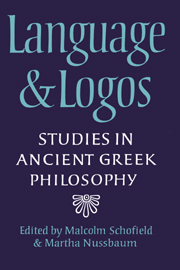Book contents
- Frontmatter
- Contents
- Preface
- Introduction
- 1 Heraclitus' conceptions of flux, fire and material persistence
- 2 Epistemology and meaning in Heraclitus
- 3 The dénouement of the Cratylus
- 4 Cratylus' theory of names and its refutation
- 5 Knowledge and language: the Theaetetus and the Cratylus
- 6 Falsehood and not-being in Plato's Sophist
- 7 Forms and dialectic in the second half of the Parmenides
- 8 Aristotle and the more accurate arguments
- 9 Aristotle on the principles of change in Physics I
- 10 Aristotle on natural teleology
- 11 Accidental unities
- 12 Aristotle's concept of signification
- 13 Saving Aristotle's appearances
- 14 Myths about non-propositional thought
- 15 Gods and heaps
- Bibliography of the publications of G. E. L. Owen
- Index locorum
- Index of names
7 - Forms and dialectic in the second half of the Parmenides
Published online by Cambridge University Press: 09 October 2009
- Frontmatter
- Contents
- Preface
- Introduction
- 1 Heraclitus' conceptions of flux, fire and material persistence
- 2 Epistemology and meaning in Heraclitus
- 3 The dénouement of the Cratylus
- 4 Cratylus' theory of names and its refutation
- 5 Knowledge and language: the Theaetetus and the Cratylus
- 6 Falsehood and not-being in Plato's Sophist
- 7 Forms and dialectic in the second half of the Parmenides
- 8 Aristotle and the more accurate arguments
- 9 Aristotle on the principles of change in Physics I
- 10 Aristotle on natural teleology
- 11 Accidental unities
- 12 Aristotle's concept of signification
- 13 Saving Aristotle's appearances
- 14 Myths about non-propositional thought
- 15 Gods and heaps
- Bibliography of the publications of G. E. L. Owen
- Index locorum
- Index of names
Summary
The second half of the Parmenides has been a source of puzzlement to generations of scholars, inspiring a wide variety of interpretations. Thanks to the groundbreaking work of Ryle and Owen, one can see this material today as offering serious reflections of conceptual and metaphysical nature. In this chapter I wish to locate the key conceptual problems that Plato addresses in this passage, and argue that Plato is here also defending and revising his theory of Forms.
General remarks
All attempts at interpretation have to come to grips with the strange structure of the passage. On the surface at least, it seems that the material is arranged into eight arguments; the arguments taken pair-wise contradict each other. This organisation is, however, not very tight. Thus it suggests that it might serve for Plato more as a frame of exposition rather than as the logical back-bone of content. For one thing, after the second argument we find a longer passage on time which begins by stating that we are starting for ‘the third time’ (155E4); commentators, taking the surface structure too seriously, have been treating this as an ‘appendix’ to the second argument. Further evidence for the hypothesis that the over-all structure is not meant very deeply is provided by the fact that the arguments are not of equal length. The second one is the longest, and the last four take up much less space than the first four.
- Type
- Chapter
- Information
- Language and LogosStudies in Ancient Greek Philosophy Presented to G. E. L. Owen, pp. 135 - 154Publisher: Cambridge University PressPrint publication year: 1982
- 2
- Cited by



